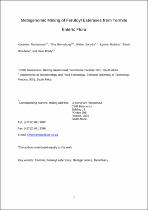JavaScript is disabled for your browser. Some features of this site may not work without it.
- ResearchSpace
- →
- Research Publications/Outputs
- →
- Journal Articles
- →
- View Item
| dc.contributor.author |
Rashamuse, K

|
|
| dc.contributor.author |
Ronneburg, T

|
|
| dc.contributor.author |
Sanyika, W

|
|
| dc.contributor.author |
Mathiba, K

|
|
| dc.contributor.author |
Mmutlane, E

|
|
| dc.contributor.author |
Brady, D

|
|
| dc.date.accessioned | 2014-03-04T08:53:14Z | |
| dc.date.available | 2014-03-04T08:53:14Z | |
| dc.date.issued | 2014-01 | |
| dc.identifier.citation | Rashamuse, K, Ronneburg, T, Sanyika, W, Mathiba, K, Mmutlane, E and Brady, D. 2013. Metagenomic mining of feruloyl esterases from termite enteric flora. Applied Microbiology and Biotechnology, vol. 98(2), pp 727-737 | en_US |
| dc.identifier.issn | 0175-7598 | |
| dc.identifier.uri | http://download.springer.com/static/pdf/356/art%253A10.1007%252Fs00253-013-4909-7.pdf?auth66=1393764638_49fe82049ba0b4fa8ed77531ed558d3c&ext=.pdf | |
| dc.identifier.uri | http://hdl.handle.net/10204/7269 | |
| dc.description | Copyright: 2013 Springer Verlag. This is the pre/post print version. The definitive version is published in Applied Microbiology and Biotechnology, vol. 98(2), pp 727-737 | en_US |
| dc.description.abstract | A metagenome expression library was created from Trinervitermes trinervoides termite hindgut symbionts and subsequently screened for feruloyl esterase (FAE) activities, resulting in seven recombinant fosmids conferring feruloyl esterase phenotypes. The amino acid sequence lengths of the seven FAE encoding open reading frames (ORFs) ranged from 260 to 274 aa and encoded polypeptides of between 28.9 and 31.4 kDa. The highest sequence identity scores for the seven ORFs against the GenBank database were between 45 and 59 % to a number of carboxyl ester hydrolyses. The seven FAE primary structures contained sequence motifs that correspond well with a classical pentapeptide (G-x-S-x-G) serine hydrolyse signature motif which harbours the catalytic serine residue in other FAE families. Six of the seven fae genes were successfully expressed heterologously in Escherichia coli, and the purified enzymes exhibited temperature optima range of 40-70 °C and the pH optima of between 6.5 and 8.0. The k cat/K M ratios for the six characterised FAEs showed the following order of substrate preference: methyl sinapate> methyl ferulate> methyl ferulate. All six FAEs showed poor conversion rates against methyl p-coumarate and methyl caffeate, both of which lacked the methoxy (O-CH3) group substituent on the aromatic ring of the ester substrates, emphasising the requirement for at least one methoxy group on the aromatic ring of the hydroxycinnamic acid ester substrate for optimal FAE activity. | en_US |
| dc.language.iso | en | en_US |
| dc.publisher | Springer Verlag | en_US |
| dc.relation.ispartofseries | Workflow;12202 | |
| dc.subject | Microbiology | en_US |
| dc.subject | Biotechnology | en_US |
| dc.subject | Termite enteric flora | en_US |
| dc.title | Metagenomic mining of feruloyl esterases from termite enteric flora | en_US |
| dc.type | Article | en_US |
| dc.identifier.apacitation | Rashamuse, K., Ronneburg, T., Sanyika, W., Mathiba, K., Mmutlane, E., & Brady, D. (2014). Metagenomic mining of feruloyl esterases from termite enteric flora. http://hdl.handle.net/10204/7269 | en_ZA |
| dc.identifier.chicagocitation | Rashamuse, K, T Ronneburg, W Sanyika, K Mathiba, E Mmutlane, and D Brady "Metagenomic mining of feruloyl esterases from termite enteric flora." (2014) http://hdl.handle.net/10204/7269 | en_ZA |
| dc.identifier.vancouvercitation | Rashamuse K, Ronneburg T, Sanyika W, Mathiba K, Mmutlane E, Brady D. Metagenomic mining of feruloyl esterases from termite enteric flora. 2014; http://hdl.handle.net/10204/7269. | en_ZA |
| dc.identifier.ris | TY - Article AU - Rashamuse, K AU - Ronneburg, T AU - Sanyika, W AU - Mathiba, K AU - Mmutlane, E AU - Brady, D AB - A metagenome expression library was created from Trinervitermes trinervoides termite hindgut symbionts and subsequently screened for feruloyl esterase (FAE) activities, resulting in seven recombinant fosmids conferring feruloyl esterase phenotypes. The amino acid sequence lengths of the seven FAE encoding open reading frames (ORFs) ranged from 260 to 274 aa and encoded polypeptides of between 28.9 and 31.4 kDa. The highest sequence identity scores for the seven ORFs against the GenBank database were between 45 and 59 % to a number of carboxyl ester hydrolyses. The seven FAE primary structures contained sequence motifs that correspond well with a classical pentapeptide (G-x-S-x-G) serine hydrolyse signature motif which harbours the catalytic serine residue in other FAE families. Six of the seven fae genes were successfully expressed heterologously in Escherichia coli, and the purified enzymes exhibited temperature optima range of 40-70 °C and the pH optima of between 6.5 and 8.0. The k cat/K M ratios for the six characterised FAEs showed the following order of substrate preference: methyl sinapate> methyl ferulate> methyl ferulate. All six FAEs showed poor conversion rates against methyl p-coumarate and methyl caffeate, both of which lacked the methoxy (O-CH3) group substituent on the aromatic ring of the ester substrates, emphasising the requirement for at least one methoxy group on the aromatic ring of the hydroxycinnamic acid ester substrate for optimal FAE activity. DA - 2014-01 DB - ResearchSpace DP - CSIR KW - Microbiology KW - Biotechnology KW - Termite enteric flora LK - https://researchspace.csir.co.za PY - 2014 SM - 0175-7598 T1 - Metagenomic mining of feruloyl esterases from termite enteric flora TI - Metagenomic mining of feruloyl esterases from termite enteric flora UR - http://hdl.handle.net/10204/7269 ER - | en_ZA |






